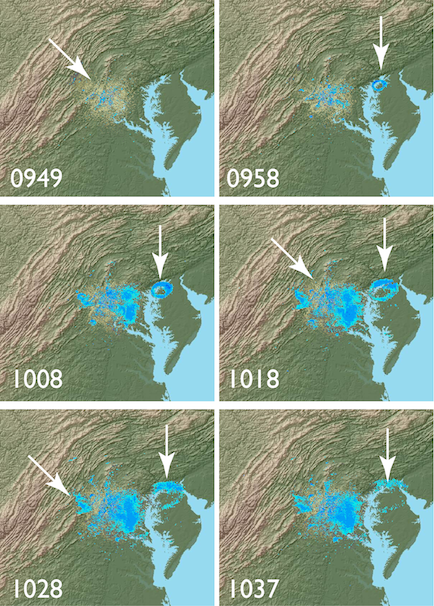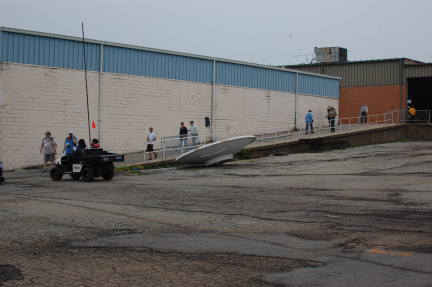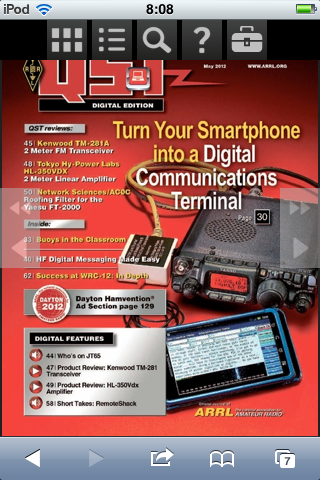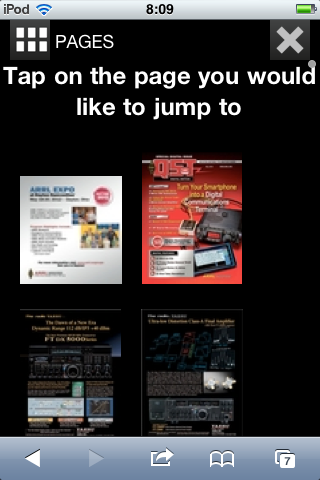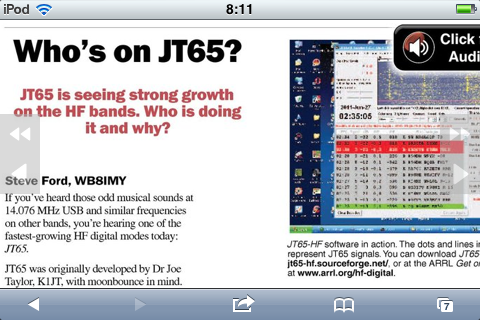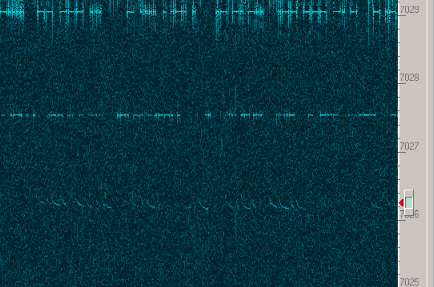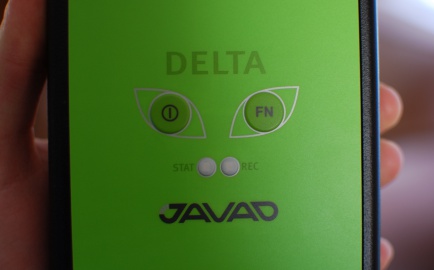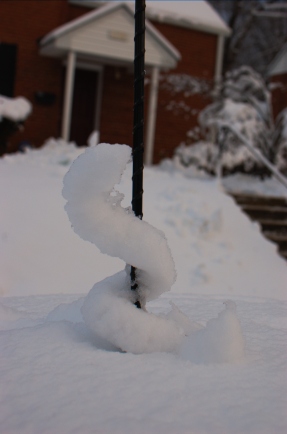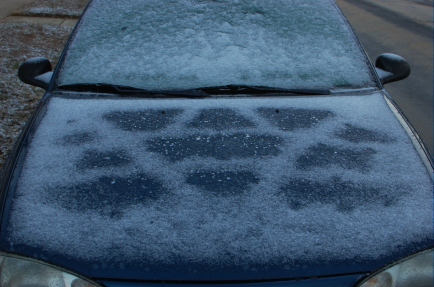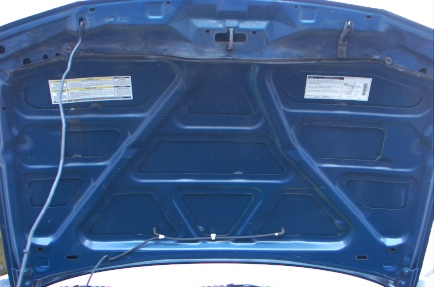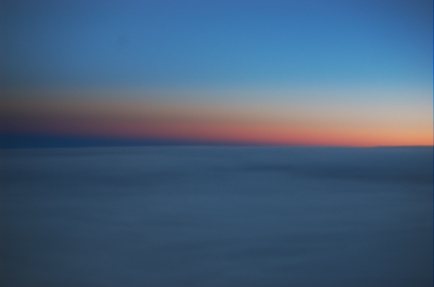I may be the only person on the Internet who, despite its namesake, finds “Pi Day” on March 14th completely irrational. Here’s why: It’s completely arbitrary. Only we in the U.S. write the date with the month before the day and year like mm/dd/yy. This violates everything sacred about significance in number systems. Normally, digits are ordered from most- to least-significant left to right or least- to most-significance. So, Pi Day including the year actually wouldn’t occur until 3141/59/27 or 31/41/5927, neither of which are real dates anyway. Therefore, Pi Day doesn’t actually exist. I propose a rational alternative definition of Pi Day to be July 22nd (22/7) of every year. Besides, red raspberries are in season in July and not in March so I can enjoy my favorite pie.
Archive for the ‘noticed’ category
The Pi Day Contrarian
March 13th, 2015Signal and Noise
August 4th, 2014“One man’s signal is another man’s noise,” began Dr. Kudeki as he derived incoherent scatter radar theory from Nyquist’s noise theorem in ECE458. I think of that statement often, whether it be QRM on the ham bands or sifting through the pocket litter of web users looking for their consumption preferences.
This morning, I admired just such an example of signal and noise while watching the NOAA Doppler weather radar. Undesired targets of a radar that return echoes are termed “clutter” in the radar parlance and one simplistic way of eliminating clutter, especially when you expect the desired scatterers (“targets”) to move, is to assume that all of the stationary returns are clutter. In the weather radar, we get clutter from all sorts of stationary things like trees, hills, and buildings. Of course, what causes the clutter to move?
You see, it was one of those humid August mornings when a ham’s mind wanders to…tropospheric ducting. Yes, indeed the clutter returns were moving, intensifying before and after sunrise. I was fixated on this and watched the loop over and over again before noticing an even more interesting bit of clutter!
Beginning at 0958 UT on 4 August 2014, there is a small ring forming out over the Elk River area. The ring, which is indicated by the downward-pointing vertical arrows, expanded over the next >40 minutes. I was puzzled and watched the loop over and over. I considered and discarded a number of theories before resorting to Google. Apparently, it’s very likely a flock of birds. Sure enough, the epicenter of the ring is Elk Neck State Park. Fascinating.
The slanted arrows in the figure above indicates the ground clutter that I was originally noticing as a signature of tropo ducting, obviously now of secondary interest in this sequence of images!
Epilogue: I sent these frames to my father, who is an avid observer of the natural world. He passed them along to two friends back home who are birders. At press time, one reported that he had learned of these “bird circles” from Greg Miller, another birder from the area who got famous as one of the subjects of the book (and movie of the same title) The Big Year. I haven’t read/seen it, but I guess they went to Adak, which has a special place in my heart. Anyhow, it’s a funny small and interesting world in which we live.
Dayton 2013 Recap
May 20th, 2013Some good planning on Sarah’s part yielded a bridal shower for her sister scheduled on the same weekend as the Hamvention. Huge win.
- Speaking of huge wins, there was no sewer back up this year.
- Like the last time I attended in 2011, I’m pleased to see more younger (than me) hams in attendance. A high-ranking ARRL official noted to me the “energy and enthusiasm” present in this generation of young hams that was not present 15 years ago (this year marks my 20th year as a ham, but I didn’t mention that). Attendance was still thin compared to my first visit in the mid 1990s.
- Deals. I stimulated the economy by purchasing a small CDE rotor for my VHF activities, an HP server power supply for a future solid state amplifier project (>55 amps at 50 volts), a couple of 900-MHz antennas, and some miscellaneous small parts. I sold some junk to partially cover that expense.
- People. Ran into a lot of old friends and made some new ones. This is really why I go to Dayton, well, that and the junk. K8MFO tells me there are Bureau cards coming. W8AV has 930s for me to work on. W2NAF had people for me to meet. AD8P was able to win himself a pizza from an unnamed W5 in the “SB-200 challenge” of correctly differentiating an SB-200 from an SB-220 at a distance of 20 feet—a tribute to the W5’s failure to distinguish the two until after the sale last year.
- W2NAF has written an article about our trip to Adak (NA-039) that was published in the June 2013 issue of CQ. It has a lot more background detail than what I wrote on the blog. Check it out. I picked up a copy of that and the May 2013 issue which has the 2012 CQ WW CW results in it.
- Products. I just don’t care that much about new products. The Ten-Tec Rebel that several people have already discussed is a cool idea. I know that Ten-Tec took some flak for not opening up the Orion SDR core when they produced it. But, let’s be realistic, people. Hams would have bricked those suckers in a heartbeat. A sandbox “open source” radio is a step in the right direction, but I question what a ham can really customize that matters without screwing it up. Maybe I’m just not visionary enough. Almost 10 years ago now, I interned in the R&D lab at a large consumer appliance manufacturer as an undergraduate my supervisor was always saying, “How can we make this attractive to the [hardware] hackers?”
- Guns. The Hamvention web site was very specific that the Trotwood Police Department would be actively enforcing Hara Arena as a non-gun zone. Seriously? It’s a ham radio convention. Bill Goodman is there at least once a month the rest of the year. Do hams bring their go-kits to gun shows? They must. Inquiring minds want to know…
- Suites. I did not do the contester suite thing. Was thinking of going on Friday night but fell asleep in my in-laws’ living room. This is a recurring problem when I visit so no one bothered to awaken me.
Was the trip worthwhile? I think so.
QST Digital Edition beta
April 22nd, 2012The other day I received, like some unknown number of others, an invitation to try the QST Digital Edition beta for the May 2012 issue. I am not a hard-core mobile/digital media user. But, Sarah is a librarian who has specialized in management and procurement of electronic journals and books. So, she gave me the low-down on what to look for. And, over the years, I’ve given her what-for about eBooks because, as I like to say, “I am willing to risk a single print copy of something by taking it places I wouldn’t risk taking an electronic reader.” That sums up the perspective I took when reviewing e-QST.
You can read about the Digital Edition on ARRL’s FAQ here. The desktop version requires Flash to use in-browser or Adobe Air and an enormous download to go stand-alone, neither of which really warmed my heart. But, it does work in the web browser of a mobile device. I have a 2nd generation iPod Touch running iOS 4 and it worked great in Safari. I now have a bit of insight as to why people might love their iPads (which I have always viewed as a more-expensive, less-convenient version of the iPod Touch or iPhone). There appear to be only two levels of zoom: fit page width and zoomed-in. No matter how good your eyesight, you need to be zoomed in to read because the characters don’t render legibly otherwise. I think iPad’s larger screen might make reading it easier.
Browsing page thumbnails was OK, but it’s difficult to actually know what you’re looking at before you select the page. It also would be nice if the pages were numbered in thumbnail view.
One of the big advantages of the Digital Edition is that you can do things you can’t do with the print version, like including audio of JT65. Granted, I think almost anyone who’s active on HF CW or digital knows what JT65 sounds like, but it’s a basic demonstration of the kinds of things that will be possible in the new format.
Given that I’m usually done with one month’s issue by the time the next one comes out, the Digital Edition is alright for basic browsing and reading. It’s much faster to skim the print issue, at least with my barebones 768 kbps DSL connection and the higher visual bandwidth of print (read Tufte’s essay The Cognitive Style of PowerPoint for more on this and other interesting reasons to hate slide decks). The mobile version also requires you to be connected to the Internet to browse. It turns out that an entire issue is on the order of 350 MB to download stand-alone on a computer. This makes it difficult to take places where I often want to read QST (on airplanes, for instance)… It is possible to print from the desktop version (I tried it using 32-bit Windows XP and Firefox), although it seems to be slower than the mobile version (not entirely unexpected).
Another thing that’s a bit different is that if you download the offline content to your desktop, you still need to authenticate to open it. It’s not clear whether this continues if you drop your ARRL membership. It is a bit different than owning boxes of back issues…even if you drop your membership, you still have the magazines. I don’t think this is a huge concern for most hams, who probably wouldn’t be interested in old QSTs if they dropped the membership.
In summary, I like the concept of the Digital Edition, but I wish I could carry off-line issues around on my mobile device. ARRL hints at this in the FAQ, so I am hopeful.
Fascinating signals: AA1TJ/QRPp
August 17th, 2011Last night, as I have been doing lately in both the evenings and mornings, I was trawling the bands with a SoftRock (a dual-band v6.0 built for 40 and 80 meters—my first SoftRock) and Rocky. Without fail, the waterfall enables me to see something interesting, which brings me to the point that I really need to integrate these receivers into my station. But, I digress. The really tantalizing, fascinating signals are the weak ones, especially when they are weak and unusual.
The subject weak and unusual signal is shown in the figure headlining this post. Rocky’s cursor shows the approximate bandwidth of the CW filter (250 Hz, if I recall correctly) and the center frequency (7026.25 MHz). I tuned it in and caught a CQ from “AA1T…” Recalling that I head read about Mike, AA1TJ‘s, Das DereLicht transmitter built mostly from parts scavenged from a dead CFL, I suspected it was him. After a moment the QSB came up and I caught the ‘J.’ Thanks to the fact that the SDR is not fully integrated into the station, I scrambled to plug my 15-year-old Small Wonder SW-40 in and get it online. Mid-scramble, Sarah handed Evan off to me for a diaper change, but I did manage to snap the screenshot above. By the time I returned to the shack awhile later to close things down, AA1TJ had disappeared.
Through the (ubiquitous) magic of the Internet, I sent Mike an apologetic e-mail QSL, which yielded a nice response. It turns out that he was trying a 40-meter version of the first transistor transmitter described in the amateur literature. The design for 146 MHz by K2AH appears in March 1953 QST. If you are an ARRL member, pull up those old QSTs in the archives and read about it. K2AH is on the cover of February 1953 QST with the same transmitter. Mike figures he was making 20 mW, or 20650 miles/Watt on the path from his station to mine. The more remarkable thing is that he was using a 1956-era point-contact transistor (the same type as in the K2AH article). Fascinating stuff! Hopefully, we’ll connect for a real over-the-air QSO sometime soon.
Thanks, Mike, for making my day by doing something interesting and sharing it on the air!
Good Design
March 8th, 2011Ice Snake
January 27th, 2011Ice on the hood
January 21st, 2011Locality Bias
January 3rd, 2011Slate Labs has an “interactive tool” to look at food deserts in the U.S. by county—places where a healthy variety of food is unavailable. They define a metric of desertification by counting the number of people who do not have access (not sure how this is defined) to a car AND live farther than one mile from a supermarket (not sure how this is defined, either). So, I went looking at some places I’ve lived.
My home county is Holmes County, Ohio. If you look at the map, it’s the one that’s an island of dark brown in the middle of Ohio. 27.91 percent of Holmes County is a food desert by this metric! Blame it on the Amish. Because the county is rural, there are few grocery stores. And, because the Amish do not have access to their own cars, they count a large portion of this population. Other counties with large Amish populations (relative to the non-Amish population) also stand out clearly.
It also appears that the map is distorted by population density, with sparsely populated areas being more prone to classification as food deserts. Is this fair? Is there anything that can be reasonably done about these areas even if they are food deserts? I don’t at all disagree that this is an important, significant problem, but it seems that there might have been a better metric. Perhaps it’s the most accessible metric with the available data?
Although this map may be revealing in many ways, it also distorts the reality a bit. For me, it’s a reminder to not consume “news infographics” too casually. I haven’t read all of the comments on the Slate piece and probably won’t. So, forgive me if someone has already noted some of the above. As a final note, most of the people who write for Slate are relatively ignorant of what happens in the part of the country between the Coast Ranges and the Appalachians. So, as one commenter wrote, it’s a “typical urbanite view” of food.
